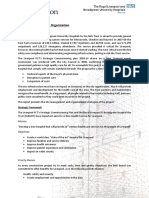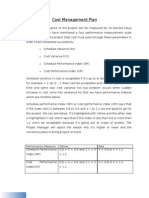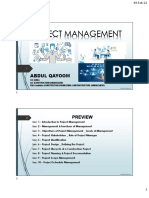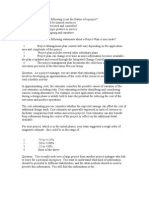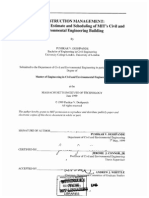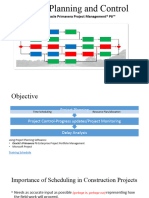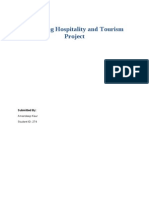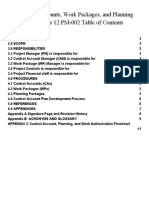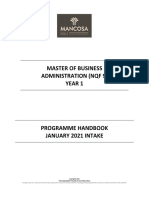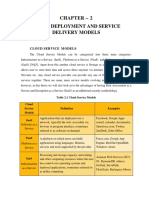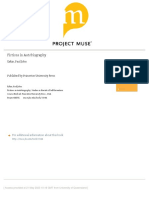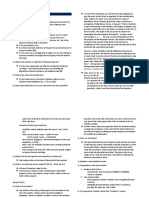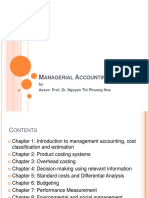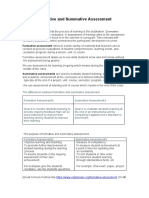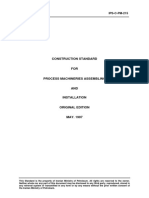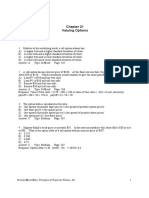ASSIGNMENT COVER PAGE
Please complete Section A and Section B below and attach the cover page to the front of your assignment
SECTION A: STUDENT AND ASSIGNMENT DETAILS (Please complete the details below in full)
Student number
139740
Title
Mr
Surname
Nthoba
Paballo Abram
First name/s
PGDPM
Programme
Intake
JULY 2019
Module
Project Resource and Procurement Management
Facilitator
Examination venue
Kimberley
First submission TICK X
Submission type
Re- submission TICK
Submission date
05/08/2019
09 Duvenhage street
Postal address
New Park
Kimberley
Work
079 965 6313
Home
Contact 083 5372973
details
Cell
079 9656313
Email
drnthoba@gmail.com
1
�SECTION B: DECLARATION (Please ensure you sign the declaration prior to submission of the assignment)
I hereby declare that this assignment submitted is an original piece of work produced by myself.
Signature of student: ____Nthoba P A__
Date: _____05/08/2019_
2
�Table of content
• the management of slack using CCPM
• Why, if there is a tendency to overestimate activities durations and add a
safety net to the end of project, do so many projects come in behind schedule.
• AON network
• Determine the slack time
• Gantt chart
• resource histogram
• smoothed resource histogram
• Reference
3
�Question 1
Critically discuss how a modern ‘theory’ on constraint management can help solve
the management of slack.
The modern theory on constraint management that can help to solve and manage
the management of slack is CCPM.
Critical Chain Project Management is a method of planning and managing projects
that puts more emphasis on the resources required to execute project tasks.
This is in contrast to the more traditional Critical Path and PERT methods, which
emphasize task order and rigid scheduling.
Hence Critical chain project management (CCPM) is basically an alternative
approach proposed by Dr Goldratt in the mid-1990s for dealing with such situations.
CCPM is basically an alternative approach which uses the theory of constraints to
manage project slacks.
Critical Chain Project Management strives to eliminate undesired effects that make
projects longer and costlier than we planned. We know the theories. Now, we look at
what CCPM addresses when compared to a traditional approach. Armed with this
knowledge, we’re ready to embark on the process.
CCPM uses buffers as strategic points that eliminate uncertainty around projects.
There are four types of buffers:
• Project Buffer - protects the project from missing its scheduled end date and
keeps the completion date unchanged. It is inserted at the end of the project
network diagram, between the last task and the completion date. It protects
project completion date, which might vary due to the changes in activity
durations in the critical chain. In other words, the size of the project buffer
depends on the activities in the critical chain.
• Feeding Buffer - is inserted between the last task on a non-critical chain and
the critical chain. These buffers are typically added to a non-critical chain so
that any delays on a non-critical chain don’t affect the critical chain.
4
� • Resource Buffer - these are set on the Critical Chain to ensure appropriate
resources (people, equipment) are available throughout the project when
needed. These resources are commonly known as Critical Resources.
• Capacity Buffer - it sets on-call resources necessary in case unforeseen
budget issues arise .
The Critical Chain Method has its roots in another one of Dr. Goldratt’s inventions:
The Theory of Constraints (TOC). This project management method comes into
force after the initial project schedule is prepared, which includes establishing task
dependencies. The evolved critical path is reworked based on the Critical Chain
Method. To do so, the methodology assumes constraints related to each task.
According to the PMBOK (5th edition; 2015) the Critical Chain Method is a schedule
network analysis technique that modifies the project schedule to account for limited
resources. It mixes deterministic and probabilistic approaches to schedule network
analysis. The critical chain concept was coined by Eliyahu Goldratt (2000).
the advantages of applying the Critical Chain Method.
CCPM inherits the advantages of:
• PMBOK: Planning and control processes.
• TOC (Theory of Constraints): Remove bottleneck to resolve constraints.
• Lean: Eliminate waste.
• Six Sigma: Reduce Variations.
5
�CCPM helps to overcome the following phenomena:
• Parkinson’s Law: Work expands to fill the available time.
• Student Syndrome: People start to work in full fledge only when deadline is
near.
• Murphy’s Law: What can go wrong will go wrong.
• Bad Multi Tasking: Bad multitasking can delay start of the successor tasks
Question 2
Why, if there is a tendency to overestimate activities durations and add a safety net
to the end of project, do so many projects come in behind schedule.
Even though project managers contingency time addition could be between one to
nine months depending on the size of the project but despite those various built in
reserves or contingencies projects still get completed late (Larson & Gray, 2011).
The critical chain project management perspective as identified by Kloppenborg
(2013) offers a number of explanations for these delays, and these includes:
Parkinson : this simply state that work expands to fill the time allocation to it. This
can be manifested in a number of ways in a project environment; work pace will
naturally be the deadline.
People will seldom hasten to finish up work that is not immediately due; they will
rather use the extra time to clear up other non-project backlog. Thus, the padded
time in the estimate will eventually be used up.
Self or personality protection: in situations where team members actually finish up
the work before the estimated time, there is reluctance to report early finishes either
to prevent a situation where such where such member’s future estimate may suffer
credibility issues or out of fear of been casted by peers as a rate buster.
Dropped baton: Goldbatt (2000) likened projects work transition to a relay team
where a great team may suffer defeat due to lack of condition since improper
passing on of the baton could turn out to be catastrophic regardless of the speed of
the team members. In the project parlance. Gained time as a result of exaggerated
6
�estimate may prove useless if the next person or group is not yet ready to take up
and work on the output of the previous person or group.
Resource bottlenecks: this refers to the delay of project activities because
equipment or other important resources are tied up with other works. This is more
apt in a multiproject organisation or environment.
Shortages of critical resources required for multiple projects cause delays and
schedule extensions
Excessive multitasking: in situations where project personnel are made to work on
multiple projects or activities concurrently, interruptions and activity splitting becomes
rampant. These add time to the affected activities and the cumulative effect of such
extra time additions could be organisation or environment.
Student syndrome: It is human nature to start a task at the very last moment and
then increase effort just before the task deadline regardless of how much time we
planned originally. Therefore adding extra time does not help getting tasks done on
time.
In conclusion for the solution
Buffer planning
It is evident that increasing buffers or trying to improve precision of project task
planning does not work because of the high level of uncertainty inherently bound to
every project. But due to the same uncertainty we need to have some level of
protective buffers in our project plans. The correct solution is to move implicit (and
invisible) buffers to the right places of the project plan and make them visible.
7
�Question 3
Construct an AON network
The Activity on Node (AON) Diagramming Method, is a graphical representation
technique, which shows the inter-dependencies among various project activities.
This diagramming method is utilized to draw the project schedule network
diagrams—for example the critical path network diagram and the critical chain
network diagram.
8
�Question 3.2
Determine the slack time for each activity to identify the critical path for the project
All activities with a slack value of zero are considered to be critical activities and
therefore they lie on the critical path (POPM, 2015:71). As calculated in Table below,
the activities with a slack of zero are B, E, H, and J. Therefor the critical path as
determined in the AON Network in Fig above is:
ACTIVITY SLACK
A 2
B 0
C 4
D 2
E 0
F 5
G 6
H 0
I 2
J 0
Critical path : Method 1
• DFI= 13
• DGI = 16
• AEJ = 13
• AEHJ = 16
• BEJ = 15
• BEHJ = 18 critical path
• CHJ = 14
• CHI = 10
• CFI = 10
9
�Question3.3
Draw the Gantt chart for the project
Activities Nov-19 Nov-19 Nov-19 Nov-19
A 2 2
B 5 5 5 5
C 3 3
D 2 2 2 2 2
E 4 4
F 2 2 2
G 2 2 2 2 2 2
H 3 3 3
I 2 2 2 2 2
J 4 4 4 4 4 4 4 4 4
Total
resourse 12 12 7 7 6 8 7 7 5 6 6 6 6 6 6 6 4 4
Question 3.4
Construct a resource histogram showing the current resource allocation and
resource loading
Resource Histogram
12
11
10
9
8
7
6
5
4
3
2
1
0 12 12 7 7 6 8 7 7 5 6 6 6 6 6 6 6 4 4
Question 3.5
A smoothed resource histogram showing how the project can be completed, without
any increase in human resource.
According to Gido and Clements (2015:220) they define resource levelling or
smoothing as a method for developing a scheduling that attempts to minimise the
fluctuations in requirements for resources. It’s a process of moving activities to
improve the resource loading profile.
10
�From the Grantt chart below, I
moved the following activities forward A, C, D, G, F, AND I as shown on the chart
below as the results it has changed the resource histogram below.
Activities Nov-19 Nov-19 Nov-19 Nov-19
A 2 2
B 5 5 5 5
C 3 3
D 0 0 2 2 2 2 2
E 4 4
F 2 2 2
G 2 2 2 2 2 2
H 3 3 3
I 2 2 2 2 2
J Total 4 4 4 4 4 4 4 4 4
resourse
per day 5 5 9 9 9 9 5 5 5 6 8 8 8 6 6 6 6 6
Smooth Resource Histogram
11
10
9
8
7
6
5
4
3
2
1
0 5 5 9 9 9 9 5 5 5 6 8 8 8 6 6 6 6 6
11
�Reference
• Agarwal, A., & Borchers, A. (2009). Managing multiple projects and
departmental performance using buffer burn index. International Journal of
Global Management Studies, 1, 1–18.
• Bevilacqua, M., Ciarapica, F. E., & Giacchetta, G. (2009). Critical chain and
risk analysis applied to high-risk industry maintenance: A case study.
International Journal of Project Management, 27, 419–432.
doi:10.1016/j.ijproman.2008.06.006
• Blackstone, J. H. Jr., Cox, J. F. III, & Schleier, J. G. Jr. (2009). A tutorial on
project management from a theory of constraints perspective. International
Journal of Production Research, 47, 7029–7046.
• Goldratt, E. M. (1997). Critical chain. Great Barrington, MA: The North River
Press
• Leach L. (2003). Schedule and cost buffer sizing: How to account for the bias
between project performance and your model. Project Management Journal,
34, 34–47.
• Lechler, T. G., Ronen, B., & Stohr, E. A. (2005). Critical chain: A new project
management paradigm or old wine in new bottles? Engineering Management
Journal, 17, 45–58.
• Goldratt, E. M. (2017, 1997). Critical chain: A business novel. Routledge.
• Herroelen, W., Leus, R., & Demeulemeester, E. (2002). Critical chain project
scheduling: Do not oversimplify. Project Management Journal, 33(4), 48-60.
• Rand, G. K. (2000). Critical chain: the theory of constraints applied to project
management. International Journal of Project Management, 18(3), 173-177.
• Burke,R.(2014). Project Management Techniques. college edition. Burke
publication international
• Gray, C.F and Larson, E.W.2006. Project management. the Management
Process. International Edition. McGraw-Hill international Edition.
12
�• Schwalbe, K .2008 international to Project Management. Cengage Learning.
Bostom, Massachusetts
• Joshi, R and Patil, V.Z(2013) Resources Scheduling of Construction project:
case study, international Journal of science and Research.
• Styne, H.(2012).Project management : A multi-disciplinary Approach(3rd
Edition). FPM Publishing, Pretoria
• Pinto, J.K 2013 Project management : Achieving a competitive Advantage( 3 rd
edition). Pearson
13


